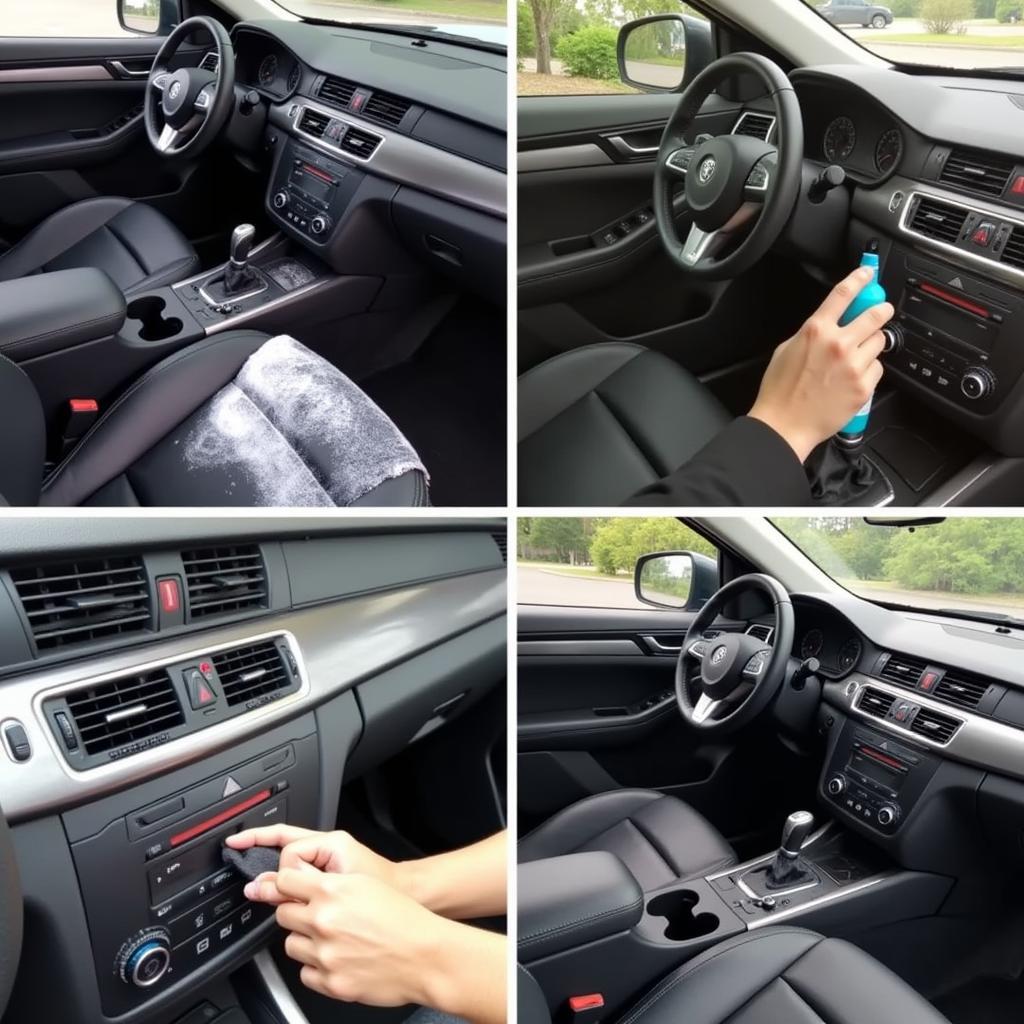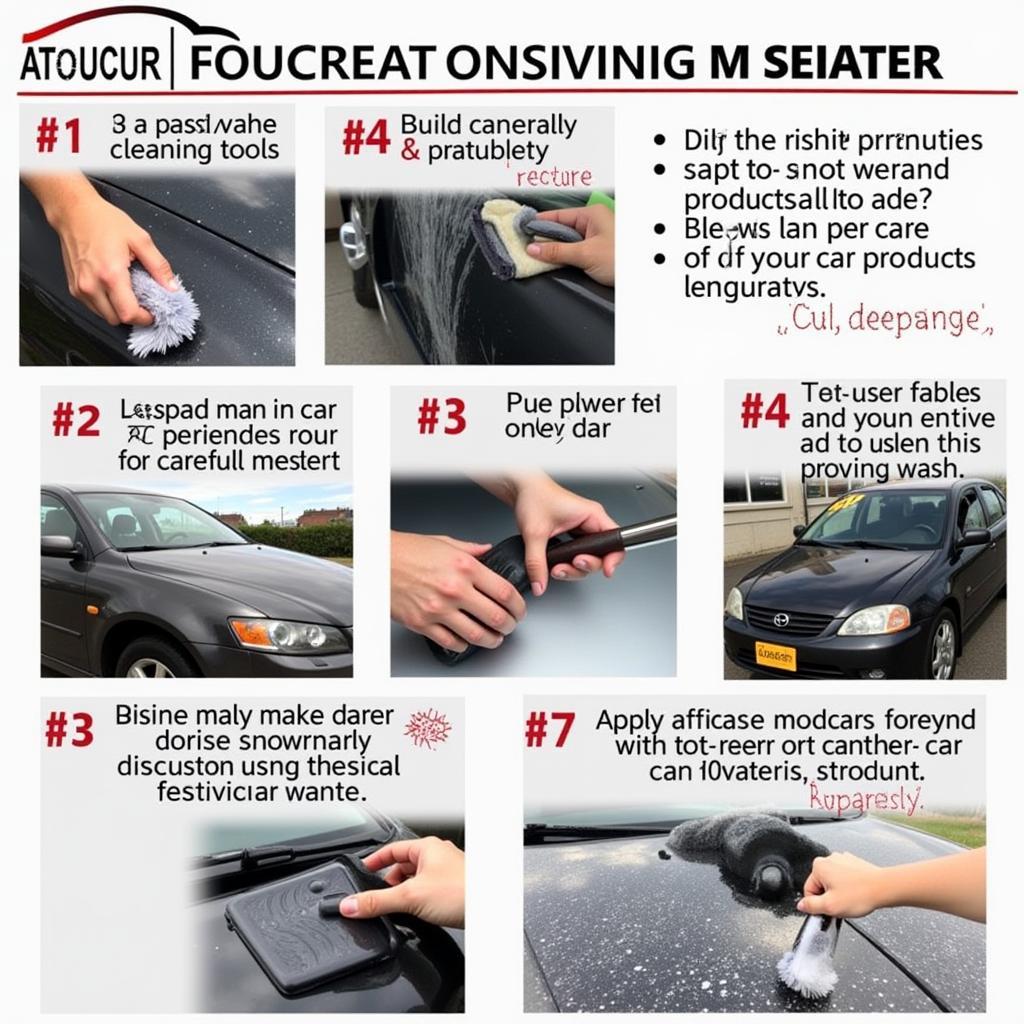Detailing In Cars is much more than a simple car wash. It’s a meticulous process that restores and enhances a vehicle’s appearance, inside and out, going far beyond a basic clean. From paint correction to interior rejuvenation, detailing elevates a car’s aesthetic appeal and can even increase its resale value. Let’s dive deep into the world of car detailing.
What is Detailing in Cars?
Detailing in cars involves a comprehensive cleaning, restoration, and protection process. Unlike a regular car wash that focuses primarily on removing surface dirt, detailing addresses every nook and cranny, restoring the vehicle to its pristine condition or even better. Think of it as giving your car a spa day.
Why is Detailing Important?
Detailing isn’t just about aesthetics. While a gleaming exterior and spotless interior are certainly appealing, detailing also offers protection. Protective coatings applied during the detailing process shield your car’s paint from environmental hazards like UV rays, acid rain, and bird droppings. This helps preserve the paint’s integrity and prevents premature fading and oxidation.
What are the key benefits? Well, regular detailing can significantly enhance your car’s resale value. A well-maintained vehicle demonstrates care and attention, making it more attractive to potential buyers. Plus, who doesn’t enjoy driving a car that looks and feels brand new? It elevates the entire driving experience.
The Detailing Process: A Step-by-Step Guide
Detailing in cars is a multi-stage process, each step contributing to the overall transformation. Here’s a general overview:
-
Washing and Prepping: This initial stage involves a thorough wash to remove loose dirt and grime. A pre-wash foam is often used to loosen stubborn dirt before contact washing.
-
Decontamination: This crucial step removes embedded contaminants like iron particles and tar that washing alone can’t eliminate. Clay bar treatment and iron removers are commonly used in this stage.
-
Paint Correction: This stage focuses on removing imperfections in the paint, such as swirl marks, scratches, and oxidation. Polishing and compounding techniques are employed to restore the paint’s clarity and shine.
-
Protection: Once the paint is corrected, a protective layer is applied to shield it from the elements. This can include waxes, sealants, or ceramic coatings.
-
Interior Detailing: This involves deep cleaning and conditioning of all interior surfaces, including carpets, upholstery, leather, and plastics.
 Interior Car Detailing
Interior Car Detailing
- Final Touches: The final touches include dressing tires, cleaning glass, and polishing exterior trim to complete the showroom finish.
Different Types of Detailing
Detailing in cars isn’t a one-size-fits-all approach. There are various levels of detailing, each catering to different needs and budgets.
-
Maintenance Detail: This is a regular service designed to maintain a vehicle’s already good condition. It typically involves washing, waxing, and interior cleaning.
-
Enhancement Detail: This level goes beyond maintenance, addressing minor paint imperfections and restoring the vehicle’s shine.
-
Full Correction Detail: This is the most comprehensive type of detailing, addressing significant paint defects and restoring the vehicle to its optimal condition.
“A properly detailed car not only looks amazing but also feels fantastic to drive,” says renowned detailing expert, John Smith, founder of AutoShine Detailing. “It’s an investment that pays off in both aesthetics and preservation.”
Common Detailing Mistakes to Avoid
Even with the best intentions, some common mistakes can hinder your detailing efforts.
-
Using the wrong products: Using harsh chemicals or abrasive cleaners can damage your car’s paint and interior surfaces. Always choose products specifically designed for automotive detailing.
-
Improper washing techniques: Using dirty wash mitts or incorrect drying methods can introduce swirl marks and scratches.
 Common Car Detailing Mistakes
Common Car Detailing Mistakes
- Neglecting the interior: A truly detailed car requires attention to both the exterior and interior. Don’t overlook the importance of a clean and well-maintained interior.
“The key to successful detailing is patience and attention to detail,” adds Sarah Jones, lead detailer at Pristine Auto Spa. “Take your time, use the right products, and focus on each step of the process.”
Conclusion
Detailing in cars is an art form that transforms a vehicle from ordinary to extraordinary. It’s about meticulous care, precise techniques, and the right products. By understanding the process and avoiding common mistakes, you can achieve a showroom shine and protect your investment for years to come. Whether you’re a seasoned car enthusiast or simply looking to keep your car in top condition, detailing is a worthwhile endeavor.
FAQs
- How often should I detail my car?
- What’s the difference between waxing and sealing?
- Can I detail my car myself?
- What are the essential tools for car detailing?
- How much does professional detailing cost?
- How do I choose the right detailing products for my car?
- How long does the detailing process take?
Need help with detailing your cars for a dealership? Check out our guide on detailing cars for a dealership. You can also learn more about detailing model cars. For those in a specific location, we have information on detailing cars on florin road. Explore more on general cars auto detailing and find information on bob buchmeyer cars detailing.
Need assistance? Contact us via WhatsApp: +1(641)206-8880 or Email: [email protected]. We offer 24/7 customer support.

Leave a Reply